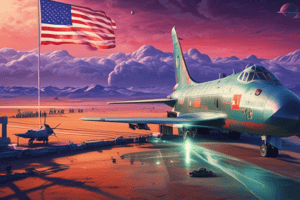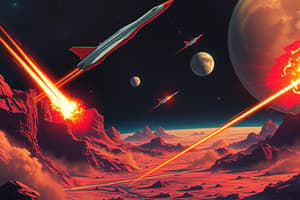Podcast
Questions and Answers
Which conference served as a direct trigger for the beginning of the Cold War?
Which conference served as a direct trigger for the beginning of the Cold War?
- The Warsaw Pact Conference
- The Potsdam Conference (correct)
- The Paris Peace Conference
- The Munich Conference
What principle did the Truman Doctrine primarily support?
What principle did the Truman Doctrine primarily support?
- Nuclear disarmament
- Strengthening NATO
- Decolonization efforts
- Containment of communism (correct)
Which event escalated tensions between the U.S. and the USSR following the Bay of Pigs Invasion?
Which event escalated tensions between the U.S. and the USSR following the Bay of Pigs Invasion?
- The Korean War
- The establishment of NATO
- The launch of Sputnik
- The Cuban Missile Crisis (correct)
Which leader of the USSR encouraged the launch of the first satellite, Sputnik, into space?
Which leader of the USSR encouraged the launch of the first satellite, Sputnik, into space?
What was a significant consequence of Mikhail Gorbachev's leadership in the Soviet Union?
What was a significant consequence of Mikhail Gorbachev's leadership in the Soviet Union?
Flashcards are hidden until you start studying
Study Notes
Overview of the Cold War
- Spanning from 1945 to 1991, the Cold War primarily involved the Soviet Union and the United States.
- It significantly impacted global political dynamics, including the space race and nuclear arms development.
Key Conferences
- The Potsdam and Yalta Conferences acted as pivotal starting points for the Cold War, shaping post-war Europe.
U.S. Containment Strategy
- The Truman Doctrine aimed to contain the spread of communism in Eastern Europe.
Leadership and Political Structures
- Joseph Stalin led the USSR at the war's onset and rejected assistance from the Marshall Plan.
- The National Security Act of 1947 created the Central Intelligence Agency (CIA) and the National Security Council (NSC).
NATO and Global Alliances
- NATO was formed in 1949 to promote peace in Europe, consisting of major European powers and the U.S.
Communist Movements in Asia
- Mao Zedong established the People's Republic of China, aligning with the USSR during the Korean War.
Space Race
- The USSR achieved the first successful satellite launch, Sputnik, under the leadership of Nikita Khrushchev.
Red Scare and McCarthyism
- In the 1950s, McCarthyism emerged, fostering paranoia that communists had infiltrated the U.S. government.
Cuban Missile Crisis
- The Bay of Pigs Invasion escalated tensions, leading to the Cuban Missile Crisis between the U.S. and the USSR.
Nuclear Disarmament Efforts
- The Nuclear Test Ban Treaty aimed to prevent nuclear weapons testing, later evolving into the Comprehensive Nuclear Test Ban Treaty in the 1990s.
Vietnam War
- The U.S. engaged in the Vietnam War to combat the communist forces led by Ho Chi Minh, emphasizing democracy.
Reagan Administration
- President Ronald Reagan introduced the Reagan Doctrine, advocating for anti-communist initiatives and the Strategic Defense Initiative.
End of the Cold War
- Mikhail Gorbachev became the USSR leader in 1985, fostering negotiations for peace and a decline in communist influence.
- The Berlin Wall fell in 1989, leading to the reunification of Germany in 1990.
- A coup in Russia resulted in Gorbachev's removal, leading to the establishment of a democracy under Boris Yeltsin.
Studying That Suits You
Use AI to generate personalized quizzes and flashcards to suit your learning preferences.




